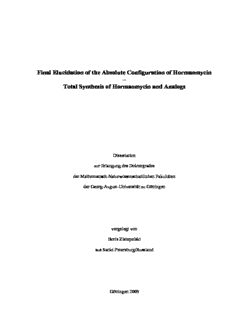
Final Elucidation of the Absolute Configuration of Hormaomycin PDF
Preview Final Elucidation of the Absolute Configuration of Hormaomycin
Final Elucidation of the Absolute Configuration of Hormaomycin – Total Synthesis of Hormaomycin and Analogs Dissertation zur Erlangung des Doktorgrades der Mathematisch-Naturwissenschaftlichen Fakultäten der Georg-August-Universität zu Göttingen vorgelegt von Boris Zlatopolski aus Sankt-Petersburg/Russland Göttingen 2003 D 7 Referent: Prof. Dr. A. de Meijere Korreferent: Prof. Dr. A. Zeeck Tag der mündlichen Prüfung: 05.11.2003 Meinem Lehrer, Herrn Prof. Dr. A. de Meijere, danke ich herzlich für die interessante Themenstellung, die während dieser Arbeit erwiesene Unterstützung und stete Diskussionsbereitschaft zu Fragen dieser Arbeit. Lisa und Anna TABLE OF CONTENTS A. INTRODUCTION...........................................................................................................1 B. MAIN PART....................................................................................................................9 1. Elucidation of the absolute configuration of 4-(Z)-propenylproline residue in hormaomycin. Synthesis of (2S,4R)-4-(Z)-propenylproline and (2S,4R)-4-(Z)-(4,1'- dideutero)propenylproline..............................................................................................9 1.1. Determination of the relative configuration of 4-(Z)-propenylproline moiety in hormaomycin. Attempts to prepare pure diastereomers of 4-(Z)-propenylproline via alkylation with (Z)-propenyllithium cuprate.....................................................................9 1.2. Elucidation of the absolute configuration of 4-(Z)-propenylproline moiety in hormaomycin...................................................................................................................13 1.3. Attempts to prepare 4-(Z)-propenylproline starting from pyroglutamic acid.................15 1.4. Synthesis of N-Boc protected 4-(Z)-propenylproline and dideutero-4-(Z)- propenylproline starting from 4-hydroxyproline.............................................................20 2. Synthesis of (R)-allo-threonine and (2S,3R)-β-Methylphenylalanine.......................31 3. Elucidation of the absolute configuration of trans-(2'-nitrocyclopropyl)alanine residue in hormaomycin. Synthesis of (2R,1'R,2'R)-(2'-nitrocyclopropyl)alanine and (2S,1'RS,2'RS)-2-deutero-(2′-nitrocyclopropyl)alanine......................................34 4. Synthesis of O-MOM protected 5-chloro-1-hydroxypyrrol-2-carboxylic acid........43 5. Final assembling of hormaomycin...............................................................................49 5.1. General remarks..............................................................................................................49 5.2. Syntheses of the selected model peptides........................................................................51 5.3. Synthesis of N-Alloc protected cyclodepsipeptide 171a................................................56 5.4. Comparative study of acidolytic deprotection Boc, Z and several Z-derived amino protecting groups.............................................................................................................59 5.5. Synthesis of N-MeZ protected cyclodepsipeptide 171c..................................................61 5.6. Final steps of hormaomycin synthesis.............................................................................64 6. Synthesis of hormaomycin analogs. Evaluation of biological activity......................68 6.1. Attempted synthesis of [(S)-(3-Acp)Ala7]-hormaomycin...............................................68 6.2. Synthesis of [(S)-(NO )Nva7]-hormaomycin. Isolation of [(S)-(NO )Nva3]- 2 2 horamomycin and [(S)-(NO )Nva3,(S)-(NO )Nva7]-hormaomycin................................71 2 2 6.3. Synthesis of [a-Dab1]-hormaomycin and [a-Dab1,a-Ile5]-hormaomycin........................74 6.4. Syntheses to [a-NαMeDab1]-hormaomycin.....................................................................77 6.5. Evaluation of the biological activity of building blocks and hormaomycin analogs as well as selected model compounds.................................................................................79 C. EXPERIMENTAL PART............................................................................................82 1. General methods............................................................................................................82 2. Preparation of substances.............................................................................................85 2.1. Determination of the relative configuration of 4-(Z)-propenylproline moiety in hormaomycin. Attempts to prepare pure diastereomers of 4-(Z)-propenylproline via alkylation with (Z)-propenyllithium cuprate...................................................................85 2.2. Elucidation of the absolute configuration of 4-(Z)-propenylproline moiety in hormaomycin...................................................................................................................93 2.3. Attempts to prepare 4-(Z)-propenylproline starting from pyroglutamic acid.................96 2.4. Synthesis of N-Boc protected 4-(Z)-propenylproline and dideutero-4-(Z)- propenylproline starting from 4-hydroxyproline...........................................................101 2.5. Elucidation of the absolute configuration of trans-(2'-nitrocyclopropyl)alanine residue in hormaomycin. Synthesis of (2R,1'R,2'R)-(2'-nitrocyclopropyl)alanine and (2S,1'RS,2'RS)-2-deutero-(2'-nitrocyclopropyl)alanine................................................126 2.6. Synthesis of O-MOM protected 5-chloro-1-hydroxypyrrol-2-carboxylic acid.............138 2.7. Final assembling of hormaomycin................................................................................149 2.8. Synthesis of hormaomycin analogs. Evaluation of biological activity.........................208 D. SUMMARY..................................................................................................................241 E. REFERENCES............................................................................................................251 F. SPECTRAL DATA.....................................................................................................261 1. 1H-NMR Spectra..........................................................................................................261 2. 13C-NMR Data.............................................................................................................273
Description: